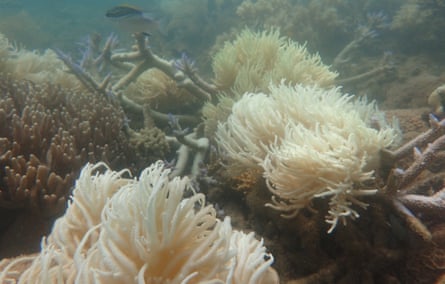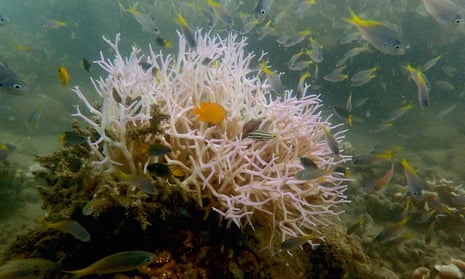The embattled Great Barrier Reef could face yet more severe coral bleaching in the coming month, with areas badly hit by last year’s event at risk of death.
Images taken by local divers last week and shared exclusively with the Guardian by the Australian Marine Conservation Society show newly bleached corals discovered near Palm Island.
Most of the Great Barrier Reef has been placed on red alert for coral bleaching for the coming month by the US National Oceanic and Atmospheric Administration (NOAA). Its satellite thermal maps have projected unusually warm waters off eastern Australia after an extreme heatwave just over a week ago saw land temperatures reach above 47C in parts of the country.
According to the Great Barrier Reef Marine Park Authority, sea surface temperatures from Cape Tribulation to Townsville have been up to 2C higher than normal for the time of year for more than a month.

The NOAA Coral Reef Watch’s forecast for the next four weeks has placed an even higher level alert on parts of the far northern, northern and central reef, indicating mortality is likely.
Corals south of Cairns, in the Whitsundays and parts of the far northern reef that were badly hit by last year’s mass bleaching event are at fatal risk.
Imogen Zethoven, the Great Barrier Reef’s campaign director for the AMCS, said the projections for the next four weeks, plus evidence of new coral bleaching, were “extremely concerning”.
The bleaching that occurred over eight to nine months of last year was the worst-ever on record for the Great Barrier Reef, with as much as 85% of coral between Cape York and Lizard Island dying. Twenty-two per cent of corals over the entire reef are dead.
Zethoven pointed to projections by NOAA that severe bleaching of the Great Barrier Reef would occur annually by 2043 if nothing was done to reduce emissions.
“The reef will be gone before annual severe bleaching,” she said. “It won’t survive even biennial bleaching.”
The $1bn reef fund announced by the prime minister, Malcolm Turnbull, in June last year was a “cynical rebadging exercise” undercut by its support for fossil fuel initiatives such as Adani’s Carmicheal coalmine “that will spell catastrophe for the reef”, Zethoven said.
“There’s no doubt about that anymore,” she said. “They know what they are doing and they should come clean with the Australian public that they have no interest in the long-term survival of the Great Barrier Reef.
“To the average person on the street, that’s what it looks like. And if the government thinks that’s not the case, they’re out of touch.”
In December last year the government’s Northern Australia Infrastructure Fund granted Adani “conditional approval” to $1bn loan for its Carmicheal coalmine and rail project in central Queensland, which could produce 60m tons of coal annually for 60 years.
Warmer ocean temperatures brought about by climate change is a key factor in coral bleaching. Polling suggests that more than two-thirds of Australians believe the reef’s condition should be declared a national emergency.
Zethoven said the government had made “a very deliberate decision to go down the coal road”, despite it jeopardising the reef’s future prospects as well as the 70,000 jobs in regional Queensland that depend on it.
John Rumney, a diving operator based in Port Douglas, said the “commercial advantage” to saving the reef went beyond jobs. Much of coastal Queensland was “majorly invested” in reef tourism, he said.

The federal government’s measures to save the reef were hypocrisy and lip service, he said, when it was simultaneously “actively supporting the cause of the cancer – the worst cause”.
“It’s immoral that those of us who are making our living from a healthy environment are paying taxes to subsidise infrastructure that’s going to cause climate change in a major way for the next 50 years,” he said. “If this all goes ahead, we’re basically dooming our tourism industry.”
Rumney said he had seen new and extensive bleaching of corals from Cairns to Townsville.
“There are definite large areas of mortality. It’s just the next depressing moment. Before, the reef has bleached and recovered but now we’re talking about how often is it bleaching and what percentage is left.”
Areas that suffered in last year’s event were now less resilient and there seemed to be less coral strong enough to spawn.
Climate change-induced mass bleaching increasingly resembled a catastrophe the reef would be unable to recover from, he said.
“It’s weaker, just like humans,” Rumney said. “If you’re already down and out with a cold or cancer, you’re less resilient – the next thing that comes along is going to knock you back more.
“It’s the continual onslaught that will eventually kill the reef.”











Comments (…)
Sign in or create your Guardian account to join the discussion